Instructional Series
This site will be closing soon as its content has moved to Tāhūrangi.
2024 titles are available on Tāhūrangi. Use the filters to find specific series.
Find Literacy resources at Tāhūrangi - Literacy.
Welcome to the English medium literacy instructional series teaching and learning resources for years 1 to 8.
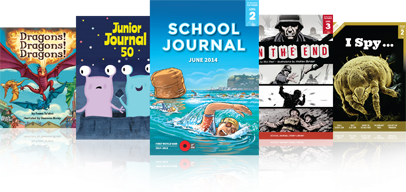
- Gold
- Purple
- Blue
- Red
- Green
- Yellow
- Orange
- Turquoise
- Magenta
- 2
- 3
- 4
- 1
- 4
- 6
- 5
- 3
- 8
- 7
- 2
- 1
- English
- Social Sciences
- Science
- Health and Physical Education
- Technology
- The Arts
- Mathematics and Statistics
- Learning Languages
- Fiction
- Non-fiction
- None
- Nature of science
- Living world
- Nature of technology
- Statistics
- Geometry and Measurement
- Planet Earth and beyond
- Technological knowledge
- Physical world
- Material world
- Number and Algebra
- Technological practice
- Gather and interpret data
- Use evidence
- Critique evidence
- Engage with science
- Interpret representations
- Articles
- Stories
- Poems
- Plays
- Activity
- Comic
- Kākano | Seed
- Tupu | Seedling
- Māhuri | Sapling
- Rākau | Tree
- Consonant digraphs
- Consonant patterns
- Initial and final blends
- Long vowels
- Short vowels
- Single consonants
- Complex morphemes
- Tense
- Vowel digraphs
- Contractions
- Syllable types
Search results
1187 items - Showing 681 - 690
-

Ngatu: Keeping the Tradition Alive
by Iona McNaughton
Megan and Lita are cousins who belong to the Tongan community in Wellington. This article describes how every week they come together with their mothers, grandmother, and other women and girls to learn about Tongan culture and how to make ngatu (tapa cloth). It explains the process of making ngatu and the significance of the cloth, and it demonstrates how such traditions are passed down through the generations.
-
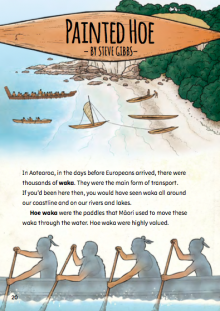
Painted Hoe
by Steve Gibbs
The first peaceful meetings between Māori and Europeans took place in 1769, when James Cook landed in the Tairāwhiti region. During those meetings, Māori traded a number of painted hoe (paddles) for cloth, seeds, potatoes, and other items. The paddles are decorated with the earliest examples of what we now call kōwhaiwhai. They ended up in museums around the world. “Painted Hoe” describes those early meetings.
-
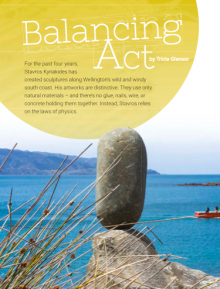
Balancing Act
by Tricia Glensor
For the past four years, Stavros Kyriakides has created sculptures along Wellington’s wild and windy south coast. His artworks are distinctive. They use only natural materials – and there’s no glue, nails, wire, or concrete holding them together. Instead, Stavros relies on the laws of physics.
-
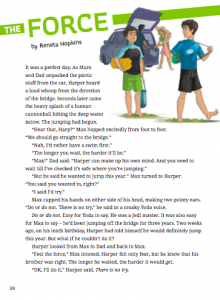
The Force
by Renata Hopkins
illustrated by Matt Haworth
Egged on by his brother, Harper works through his fears of jumping off the bridge into the water. "Do or do not. There is no try."
-
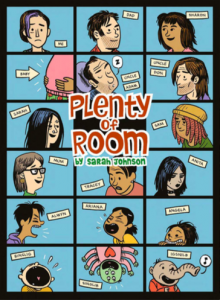
Plenty of Room
by Sarah Johnson
illustrated by Dylan Horrocks
The story of a girl adjusting to life with a new sibling. "Sometimes I just want to be alone. Know what I mean? It’s good. Gives you a chance to think. I don’t like hanging out with other people all the time. I need space. So you can imagine how I feel when Dad tells me Sharon’s having a baby."
-
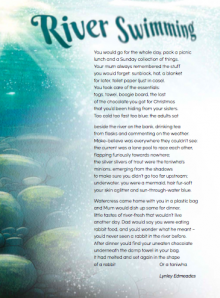
River Swimming
by Lynley Edmeades
illustrated by Ned Barraud
“River Swimming” is a beautiful poem that captures the imaginative, make-believe world that children inhabit. The setting is a day out at the river. While the adults sit and drink tea on the river bank, the children race each other in an imaginary lane pool and become mermaids, remembering to keep a safe distance from the taniwha upstream. The poem is rich in imagery and movement. It draws on the pleasures of picnics, swimming, and the beauty of the natural world. The poem would be useful for a poetry reading.
-
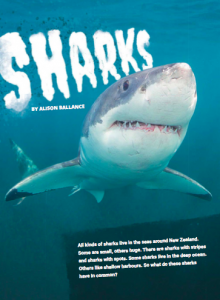
Sharks
by Alison Ballance
illustrated by Gavin Mouldey
This article provides information on sharks, focusing particularly on sharks found in New Zealand waters such as great white, rig, and deep-sea sharks.
-
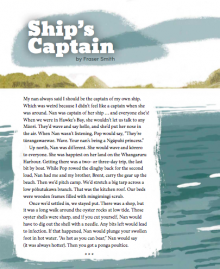
Ship's Captain
by Fraser Smith
illustrated by Daron Parton
"Ship's Captain" is the story of two boys learning how to live off the land and sea. Nan is a larger-than-life character, steeped in knowledge of bush lore and rongoā (Māori medicine). Pop is a gentle background force, who teaches the boys how to build a whare raupō. The lessons the writer learns go beyond bush lore; the story explores the value of knowledge that is passed down through generations, the pleasures of living simply, and the importance of being "the captain of your own ship".
-
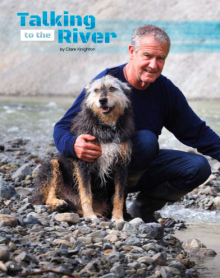
Talking to the River
by Clare Knighton
“Talking to the River” tells the story of a farmer and a group of engineering and computing students from Victoria University of Wellington who collaborate to gather data about river pollution and publicise it. River pollution is a topical issue, and “Talking to the River” provides an example of people dedicated to making a difference. The article explains the impact cows can have on rivers and the importance of being able to accurately measure levels of river pollution. The university students overcome several challenges to create a prototype monitoring device that is fit for purpose. The reach of the project is extended exponentially by creating an app that tracks river improvements and allows users to upload photos to a website.


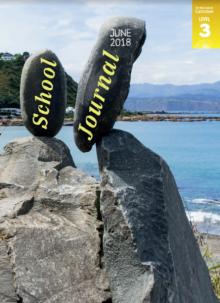
 Literacy Online home
Literacy Online home
